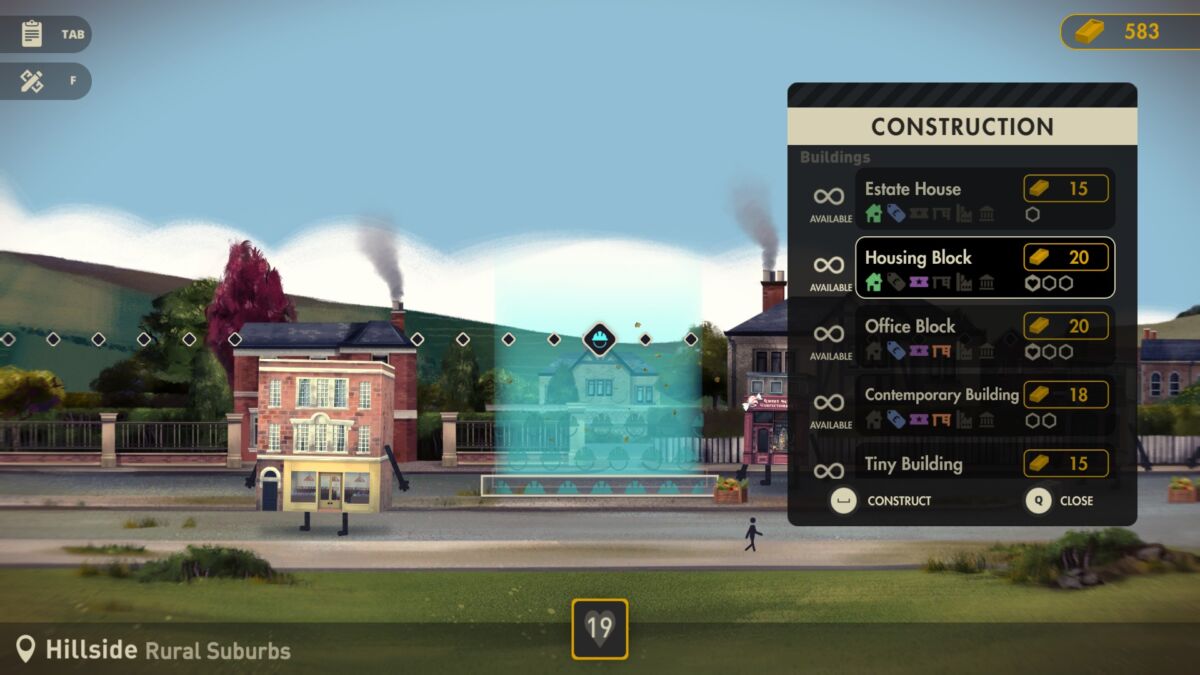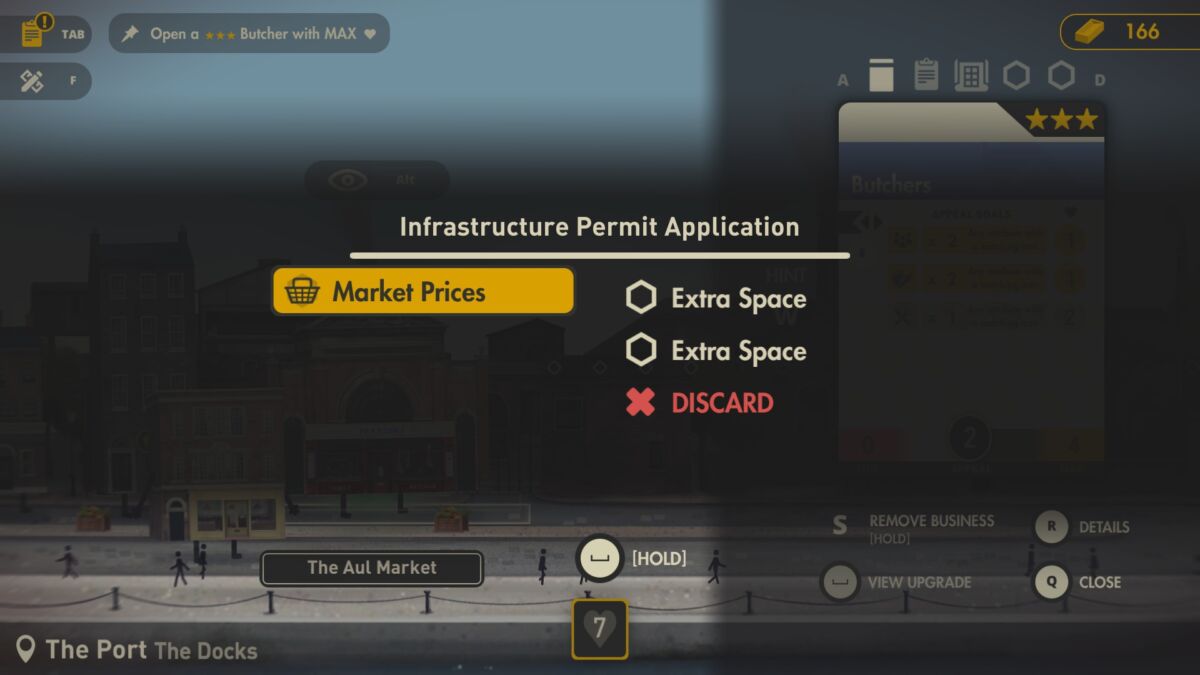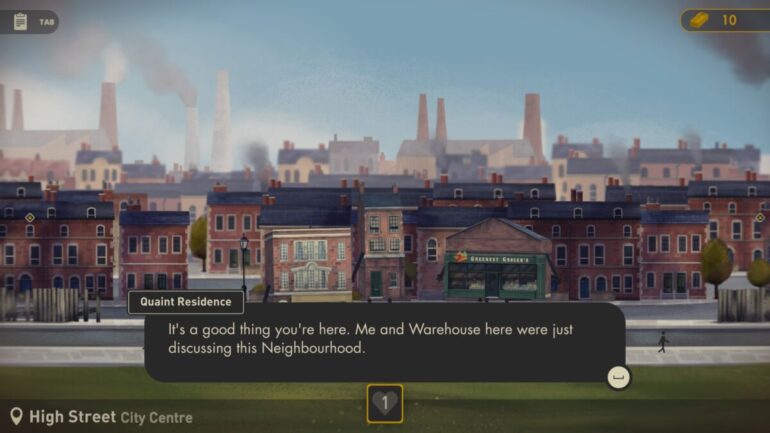
How and where did this go wrong? All the bricks to make Blackstaff Games’ Buildings Have Feelings Too a fun and relaxing strategy game are here, but it all crumbles into a frustrating chore before long.
Buildings Have Feelings Too is a city builder and management hybrid set in an abstract version of 20th century Britain. Players will go through a number of neighborhood stages completing quests and objectives usually by placing down buildings and opening businesses, all in service of raising the neighborhood’s appeal rating.
Buildings Have Feelings Too audio and visuals are its brightest elements. The game’s charming aesthetic and fun dialogue between the anthropomorphic buildings gives the game an endearing quality. The music is also quite nice with melodies that suit each neighborhood. The choice of buildings as the main characters is a neat twist on the management and city builder genre and feels like a fresh take as a result.

Unfortunately, this is where most of the praise ends. The core gameplay, while functional, has significant lapses in its design. There’s no shortage of things to see and build thanks to the large variety of buildings and a whole slew of different businesses to unlock over six different types. In addition, space is a scarce resource and businesses themselves have limited effect ranges, which encourages clever and efficient planning and positioning. It’s definitely a great feeling slotting a building in the perfect spot to make its neighbours happier and lead to an upgrade.
However, there are a couple of issues that prevent the gameplay loop from being as tight as it’s aiming to be. Buildings have a disrepair rating, which has to be accounted for to prevent the buildings from auto-demolishing. All it takes is an insignificant sum of Bricks, the in-game currency, to repair a building. That, or simply manually demolishing the building and replacing it at no additional cost. Buildings in a poor state just don’t have the impact on management as the developers seemingly intend.
In addition, different building types have Infrastructure Permit slots that can add additional effects. The problem here boils down to the lack of sufficient control and knowledge players have in maximizing the impact of these permits on their decision-making. This system just sort of exists without much guidance, leaving players uninformed on the available options.

Another gameplay issue is a missed opportunity in the interaction between buildings and the population, which is basically a resource produced by certain businesses. The missed opportunity lies in the lack of a two-way street system where buildings affect the population and vice versa. It makes each neighborhood feel the same and reduces strategic decision-making depth.
Buildings Have Feelings Too is an annoyingly buggy game. Bugs ranged from simple UI elements getting stuck and obstructing text and vision to language switching for no reason and music, and occasionally ambient noise, cutting off after loading into a save. The worst of the bugs either broke or corrupted my save file to where I wasn’t able to travel from one neighborhood to another and the game would get stuck in an infinite saving loop, forcing me to restart the playthrough from the very beginning.
Performance is also an annoying mixed bag. For the most part, the game ran fine with no frame drops or stutters, yet in one of the later neighborhoods it’d stutter and start to crash, forcing a full program restart. Other irritating performance elements I encountered were puzzlingly long loading screens and some occasional input lag.

In addition to its menagerie of bugs, Buildings Have Feelings Too has a host of balance issues, which diminish its strategic and decision-making potential. The first issue is that all vital operational resources, such as Bricks and buildings, are way too readily available. It’s very easy to become flush with cash quite early, which basically makes it a nonfactor in city building.
In addition to Bricks being inconsequential, as players unlock newer and fancier businesses, they de facto lock off older ones as they provide little impact to the neighborhood’s development. Most of the unlockable businesses are more resource efficient compared to their earlier counterparts. Granted, it’s more difficult to upgrade these newer businesses, but not to the point of foregoing them entirely in favor of the simpler and less efficient early businesses.
Oddly, some sections of the game limit certain building types, but not others. Since there’s a good variety of buildings it seems the developers are encouraging players to use them all, but there’s no real incentive to do so. As a result of limited space, there’s little reason to use anything but the smaller footprint buildings.

The most significant issues with the game, though, are its controls, UI, and presentation of information. A simple way to sum up the main theme of these issues is that Buildings Have Feelings To was clearly designed for consoles and the PC port was an afterthought.
On PC, most of the controls are bound to the keyboard, which for a strategy management game, though not terrible, is still wonky, frustrating to move structures, and will take some time getting used to. Inexplicably, there are some sections, such as the in-game pause menu, that require only the mouse, despite everything else utilizing the keyboard. The worst part is that the game doesn’t utilize the PC’s greatest advantages for player flexibility, such as the lack of any control options (there’s barely an options menu to begin with), key rebinding settings, or even an indication of controller support.
Layering on top of the awkward controls is the inefficient and exceedingly fiddly UI. The UI is basically menus upon menus and more menus, forcing the player to painstakingly flip through many elements just to find some small piece of information. Though the UI is certainly stylized and has a nice aesthetic, such an approach undermines the UI. So on top of an unhelpful UI paired with awkward controls, what else could go wrong?

The most egregious of the trinity of failures is the way information is presented to the player. The tutorial is presented in a series of dialogues and pop-up cards that explain the game’s concepts. The game also clearly states that players can look back into the Guides section to refresh their memory. However, some portions of the tutorial are either not in the guide or presented with confusing and unclear wording.
Another example of poor information presentation is that the game never really clearly states its ultimate goal. Is it a casual narrative city-builder to complete quests? There aren’t enough narrative or role-playing features. Is it a high score game with the goal of increasing appeal as much as possible? To what extent should players focus on neighborhood appeal? There doesn’t seem to be a leaderboard or any other system that shows appeal progress, nor does global neighborhood appeal have some practical and tangible effect. It makes the player’s involvement somewhat aimless and empty.
Finally, Buildings Have Feelings Too is pervaded with confusing wording that risks blocking player progress altogether. I reached a point in one of the later stages of the game where one of the quests formulated an objective in such a foreign way compared to the rest of the game that it made me question my understanding of English altogether and essentially prevented me from progressing. Either the developers didn’t check how players would perceive the game’s texts or the game is simply broken in its progression. Regardless it’s a huge issue.

Adding insult to injury, there are two smaller issues that seal the deal. Throughout the game, there’s a sense that it’s building to something and will at one point open up to test and challenge the player’s skills. Since I couldn’t get to such a point (if there even is one), based on the aimlessness of the game I can only go out on a limb and predict that never happens.
The second issue is a complete lack of accommodation for experimentation. A vital element in management and city builder games is for the player to be able to experiment and figure out effective and creative strategies to optimize their city and keep their interested parties (buildings in this case) happy and attended. Buildings Have Feelings Too only has three save slots and each slot only quicksaves, preventing players from jumping back to earlier stages.
Not only that but there’s also no ease-of-access system for players to quickly reshuffle their neighborhoods or bounce around with their avatar to rapidly shift businesses and buildings around. Players will have to go with the painfully slow manual method of waiting for their avatar to move from one end to the other, all the while awkwardly going through the multi-stage demolition process for each structure. Unless the player has a perfectly laid out plan in their head, any major restructuring after placing buildings down will be an absolute chore.
It’s heartbreaking to see the state of Buildings Have Feelings Too, as it’s abundantly clear that the developers care for their game. The game has character, charm, and flavor that just gets squashed by questionable gameplay design and horrendous technical implementation. Players will spend more time fighting the game than enjoying their time with it. Buildings Have Feelings Too may fare better on consoles, but as a PC game it’s a hard pass.
A copy of Buildings Have Feelings Too was provided by PR for the purposes of this review.
READ NEXT: 20 Best Strategy Games To Mull Over
Some of the coverage you find on Cultured Vultures contains affiliate links, which provide us with small commissions based on purchases made from visiting our site.


